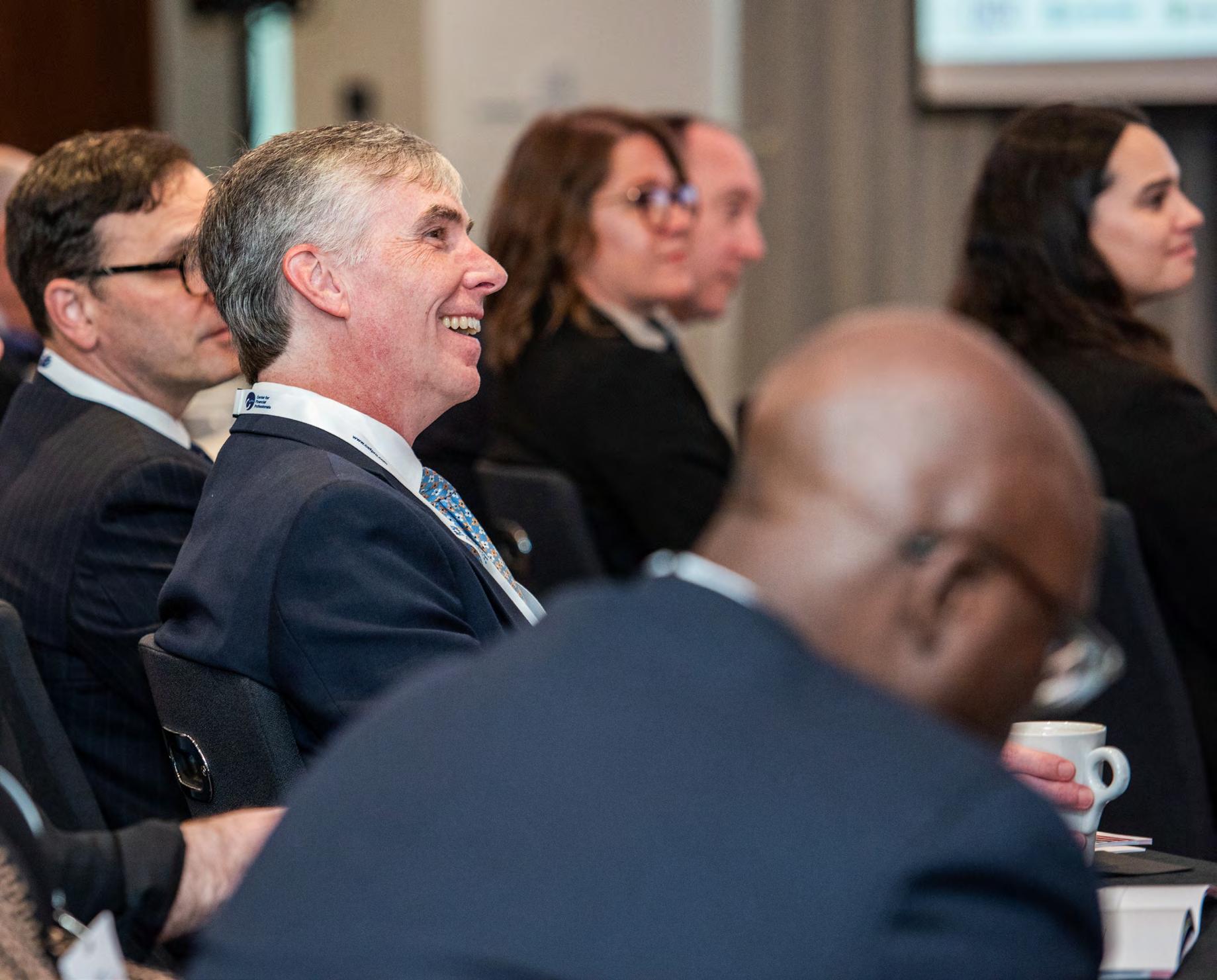CeFPro® magazine for non-financial risk professionals


CeFPro® magazine for non-financial risk professionals

How COP28 and climate risk are setting the agenda for investment strategy
What does COP28 mean for the future? Why financial institutions must take advantage of ESG investment opportunities
Will AI replace your role in Cyber?
Risk intelligence specialists on upskilling for a changing world
Is your ESG talent selling you short? How proactive ESG talent strategies are key for investment success
FinTech Leaders 2024: The results are in! Find out what’s dominating the agenda in 2024
Adhering to disclosure requirements across multiple standards and jurisdictions
EBRD on the need for a consistent approach to ESG risk
The evolution of climate stress testing and risks on the horizon
Research review of climate impact on financial performance
3
4
FOREWORD
2024 Sustainability Outlook: trends to look for in the year ahead
Marina Severinovsky, Schroders
THE BIG CONVERSATION
What does COP28 mean for the future?
Markus Müller, Deutsche Bank & Maria Lombardo, Standard Chartered Bank
14
INFOGRAPHIC
Key outcomes and pledges of COP28
8
10
AI AND THE FUTURE
Will AI replace your role in cyber?
Craig R. Spielmann, RiskTao LLC, & Lauren DiNunzio, Fortune 500 company
TALENT ACQUISITION
Is your ESG talent selling you short?
Ekaterina Grigoryeva, The World Bank










16
FINTECH LEADERS
AI and cybersecurity dominate fintech thinking
EVENT PREVIEW
20
The evolution of climate stress testing and risks on the horizon
Caitlin Saykal, CeFPro
DISCLOSURE FOCUS
22
Adhering to disclosure requirements across multiple standards and jurisdictions
Vesselina Haralampieva, European Bank for Reconstruction and Development (EBRD)
The views and opinions expressed in this publication are those of the thought leader as an individual, and are not attributed to CeFPro or any particular organization.



























Sustainability considerations are critical in determining the viability and longevity of businesses and clients’ comfort level with long-term asset investment in particular companies.
Investing also continues to evolve. The new year has been shaped by several trends that show that we are no longer in the early stages of the adoption of green principles; instead, we now find ourselves in a period that reflects a deeper understanding of, and a more nuanced approach towards, sustainable investing.
Broadly speaking, as investors have become more comfortable with sustainability as an investment discipline, demand has matured. Investors are ready for the next step, beyond the integration of ESG considerations into their investment process as a risk-mitigation tool, to more specific approaches that could directly benefit from the longer-term trends that are reshaping the global economy.
Three of the most critical long-term trends are demographic change, deglobalization, and decarbonization: also known as the ‘3Ds’ of sustainable investing.
At COP28 in 2023, participants reached a significant milestone in the drive for sustainable energy generation and agreed to ‘transition away from fossil fuels in energy systems’.
Nature-based solutions to climate change also received heightened attention at COP28. This is important, as investment in nature is a costeffective and sustainable way to reduce net global emissions. Much more global climate finance investment must pivot in this direction.
Some headwinds do remain. The politicization of sustainability messaging is likely to continue in the US throughout 2024, as the country prepares for its presidential and state elections. We also expect that regulation in the US will solidify further.
The good news is that investors now see sustainability trends as real investment opportunities. They also recognize that harnessing the principles of sustainable investing will enable them to build more resilient portfolios in 2024 and beyond.
 Marina Severinovsky Head of Sustainability, North America Schroders
Marina Severinovsky Head of Sustainability, North America Schroders
We welcome contributions. If you or your organization are interested in featuring in our next issue, please contact infront@cefpro.com
CONTENT AND AUTHOR SUBMISSIONS
infront@cefpro.com
ADVERTISING & BUSINESS DEVELOPMENT
If you are interested in sponsorship and advertising opportunities, please contact: sales@cefpro.com
www.cefpro.com

What does COP28 mean for the future?
 Markus Müller MD, Chief Investment Officer, ESG Private Bank Deutsche Bank
Markus Müller MD, Chief Investment Officer, ESG Private Bank Deutsche Bank
 Maria Lombardo Global Head of ESG Advisory Sustainable Finance Standard Chartered Bank
Maria Lombardo Global Head of ESG Advisory Sustainable Finance Standard Chartered Bank
What, for you, are the top takeaways from COP28?
Markus:
We all know the explicit formal outcomes from COP28: tripling the commitments to renewable energy, a commitment to transition away from fossil fuels, and so on. But, for me, there were two equally important and implicit takeaways.
First, we need to think more about the detailed process of change, not just the need for it. The tussle over the ‘transition’ wording in the final COP28 statement showed that economies still prioritize existing economic structures. While this may be rational in the short-term, it is irrational in terms of securing long-term future development and survival. As the concept of ‘path dependency’ makes clear, it is not just where you want to go – it is where you start too.
Second, the social and economic opportunities generated by this change will be vast. I heard this repeated loud and clear at all the talks with corporates, governments, and NGOs, as well as the discussions with youth groups. All agree that change should not be seen as risk; on the contrary, it will be the source of future employment and prosperity. But, circling back to my first point, how do we make change happen and keep it delivering acceptable results?
My third takeaway is that I am always impressed by the scope of the conference, specifically the range of subjects discussed, the deep knowledge of the participants, and their willingness to listen and learn from nature. COP28 was my 4th COP, so I feel I am becoming a veteran of these international meetings.
Maria :
Although COP28 feels like it was a long time ago, the momentum built in Dubai is continuing to catalyze positive climate action across the globe. From my vantage point as an advisor to clients in emerging and developing economies across Africa, the Middle East, and Asia on their sustainability strategies and transition planning, COP28 had a real impact. The conference reinforced the need for all sectors to integrate sustainability into their decision-making and has spurred the work of corporates and regional financial institutions in translating ambition into action. I have seen this first-hand through my role at Standard Chartered, and it gives me comfort to see businesses across a wide range of sectors making progress, despite the ongoing operational and regulatory challenges.
Of course, while some left COP disappointed by the level of ambition in the final deal and expressed concern that the funds committed towards loss and damage fall far short of what is required, their disappointment has been countered by progress in two areas of innovation that Standard Chartered is looking to scale and embed: blended finance and high-integrity voluntary carbon markets. Both these innovations will play a critical role in making a sustainable and inclusive transition a reality.
Blended finance is a mechanism for helping catalyze the investment needed to deliver a just transition by ensuring both the risks and rewards are jointly shared by governments, public institutions, multilateral development banks, and private finance. We have seen the benefits of this approach firsthand through our work on the Just Energy Transition Partnerships in Vietnam and Indonesia; it was encouraging to see a raft of other public-private partnerships and initiatives announced in Dubai.
High-integrity voluntary carbon markets were also acknowledged at the conference. They can play a key role in mobilizing capital to where it is needed and have been recently boosted by the strong public support of US Climate Envoy John Kerry, and World Bank President Ajay Banga. Despite challenges relating to Article 6 negotiations, this marks an important step change as we look ahead to 2024, with parties now focused on convergence and consolidation to establish confidence and engender trust.
How do you expect these changes to impact financial services in the near term?
Maria:
When we think about how rapidly things are moving and how quickly businesses are having to adapt, it is important to remember that the book of sustainable finance has not yet been written. As a result, I think it is highly likely that we will continue to see a lot of innovation within financial services in the near term.
Our own approach to innovation is guided by the diversity of our market footprint. We know there is no silver bullet for emerging and developing economies. That is why we offer customized ESG advisory and support to ensure we can deliver solutions that speak to our client’s unique needs, ambitions, and challenges. We want to help them find a clear path to transition. What that means in practice, is that we will continue to incentivize investment in the solutions that we know will help make the transition to net zero a reality, particularly regarding those where we are already seeing tangible progress, such as the financing of wind, solar, and electric vehicles.
Alongside this, we are applying an innovation mindset to develop new financial tools, structures, and technologies to help unlock the areas where capital is not flowing at scale or at all. For example, through Standard Chartered’s dedicated innovation hub, we are exploring how we can advance some of the emerging sectors of sustainability that are currently nascent but can present future opportunities for scale, including adaptation finance, blended finance, and naturepositive solutions.
Markus:
International finance has to work out how best to support this process of transition, which will be (as noted) path-dependent and vary between sectors. To do this, financial services need to deepen their understanding of the ocean and nature and then integrate this knowledge into financial decision-making and risk management. To achieve this, they will need to draw much more on non-financial expertise. I got a lot of positive feedback at COP28 about Deutsche Bank’s decision to set up its Nature Advisory Panel. This facilitates open discussions with independent thought leaders on nature-related issues and our financial approaches.
How do you see this evolving in the future?
Markus:
Depletion of nature and its ecosystem services will increasingly be seen as a risk driver for investments –and one that can amplify the effects of other types of risks, including geopolitical. Financial market solutions will need to reflect this, as will business models. Understanding and pricing nature-related risk will need knowledge and different sorts of skills, providing (for example) new roles for insurance companies. But, again, this needs a shift of attitude to understanding risk not as a burden but as an incentive to transform our economic system. Banks should make sure they are well-placed to support such a transformation. However, policymakers may need to support them by assisting the development and regulation of some markets.
Maria:
As climate impacts worsen, with deep consequences across the global value chain, stakeholder expectations will change rapidly. We anticipate a significant increase in demand for our ESG advisory services in response to this, as clients look to build resilience into their business to ensure long-term viability. Some of the areas we can expect to see a growing focus on are sustainable supply chains, climate change adaptation, and biodiversity protection and restoration.
I also expect more and more interest across the board in how to deliver a transition that is just and inclusive, particularly for the sectors that will experience largescale workforce disruption. This is where developing the right financial instruments to facilitate inclusive, sustainable development will be key. I have already mentioned blended finance as an important example of this. Approaches like these have the dual benefit of facilitating the flow of private investment towards sustainable projects that would otherwise have required concessional capital to attract investment and incentivize governments to put in place initiatives to protect communities and enhance social mobility. This is just one example of how, through thoughtful innovation, we can turn challenges into opportunities and deliver sustainable prosperity in our markets.
How successful do you see COP28 as being for financial services?
Maria:
“The book of sustainable finance has not yet been written. As a result, I think it is highly likely that we will continue to see a lot of innovation within financial services in the near term."
Maria Lombardo, Global Head of ESG Advisory Sustainable Finance, Standard Chartered Bank
COP28 is, above all, an intergovernmental process. As a result, the question is not about whether it is deemed to be a success for the private sector, but instead, how the private can support its objectives. From that perspective, the financial sector’s mandate is clear: we must help mobilize capital at scale to facilitate a sustainable and inclusive transition. This is both an imperative and a commercial opportunity for us at Standard Chartered. After all, as we think about the greatest transition in history and the quantum of financing required to meet this challenge, we have every potential to be the bank of choice for our clients. We will achieve this by listening and partnering closely with them, applying our deep expertise and innovative
mindset, and delivering the right financial solutions that can help them manage trade-offs and realize sustainable growth.
Markus:
What COP28 did was confirm that financial services need to be part of this process of change – otherwise, it is not going to happen. This can be considered a ‘success’, but it is not the end of the story. As a society, we need to discuss how now to use finance as a tool. We will always come back to the issue of fairness. Making sure that financial services deliver more finance to poorer countries, e.g., to reduce emissions or adapt to the effects of climate change. I think this issue of fairness is going to be a big issue at COP29 in November 2024 and the two COP16 meetings that
surround it – on biodiversity and desertification. In the long-term, ‘success’ for financial services should be measured in terms of delivering sustained and fair flows of transition finance around the globe.
“Financial services need to deepen their understanding of the ocean and nature and then integrate this knowledge into financial decision-making and risk management.”
Markus Müller MD, Chief Investment Officer, ESG Private Bank Deutsche Bank


David Carlin Head of Climate Risk and TCFD UNEP FI

Aleksandra Schellenberg Global Head Legal Sustainable Finance UBS

Javier Francisco Munoz Global Head of Conduct, Reputational Risk & ESG Santander Corporate & Investment Banking

Sharon Bloemendal Global Head of Sustainability Management ING Group
JUNE 10-11 LONDON

This article presents unbiased information on AI’s impact on cybersecurity jobs, empowering readers to form their own opinions.
Marvin Minsky was an MIT professor and founder of the MIT Artificial Intelligence Laboratory in 1959 who developed the concept of artificial general intelligence (AGI). In his 1961 paper “Steps Towards Artificial Intelligence”, Minsky suggested that AI has the potential to solve complex problems involving large amounts of data and can be used to create new and innovative solutions. Fast forward 62 years to 2024 when AI has taken the world by storm and has influenced markets and politics on an enormous scale. The market value of AI companies, including Nvidia and Microsoft, has risen quickly. Taiwan’s role as a major producer of AI chips has led to its increased prominence in US-China political discussions.

On a human scale, what does AI mean for the job market? Today, AI is quickly becoming part of daily life and, more importantly, has the potential to impact employment. Is this a positive or negative trend for the global workforce? A recent example of AI’s impact on employment was the writers and actors strikes of this past summer. One of the key concerns raised by the striking writers and actors was the studio’s use of AI and intellectual property rights. According to a July 23, 2023, Fortune article by Andrew Dalton and the Associated Press, the studios wanted to scan a background performer’s image, pay the performer for half a day, and then use the performer’s image in the future without seeking the performer’s consent. Additionally, it doesn’t take much imagination to see AI writing scripts, and screenplays, creating stories, and putting writers out of work. Storytelling is unique to humans and has influenced behaviors for thousands of years.
Is it possible for AI to potentially replace cybersecurity jobs?
When was the last time you called your insurance company? Your doctor’s office? Or any large business and immediately spoke to a human? You probably can’t remember a time you called and didn’t speak to a robot first. Customer service is one of the first jobs slowly being taken over by AI.
You may have gone into cybersecurity thinking cyber professionals will always be in high demand, but now you may be wondering if your job could be replaced by AI. Concerns regarding AI replacing human jobs are valid. However, the reality is likely to be more nuanced. Recent studies, like a 2023 report by McKinsey Global Institute, highlight AI’s proficiency in specific tasks, particularly data analysis and pattern recognition. Yet, despite this proficiency, humans have crucial advantages in strategic thinking, creativity, and adapting to the unexpected. This suggests a future of humanAI collaboration, where AI performs routine tasks, while humans provide guidance, oversight, and ethical decision-making. For
example, in cybersecurity, AI could analyze vast data sets for potential threats, while human experts “coach” it to accurately interpret the data and make optimal decisions. As AI becomes more prominent in many fields, humans continue to play a valuable role.
What cybersecurity jobs will AI generate?
AI will make a great impact on the cybersecurity workspace with its automation capabilities. However, it may also create new job opportunities for individuals who are skilled in using AI.
As organizations slowly introduce AI solutions to their cybersecurity programs, the need for professionals who are proficient in applying AI tools will increase. Short term, companies will struggle to implement AI without personnel who know how to apply it. This need for knowledgeable AI professionals will open doors for a multitude of potential roles, including:
• Data Scientists who develop and train AI algorithms that optimize security systems and tools.
• Skilled AI cybersecurity analysts who can bridge the gap between traditional security experts and AI capabilities. They have the potential to apply AI tools that can analyze vast amounts of data, identify security threats, and optimize incident response processes.
• AI security architects who can oversee the design, implementation, and ongoing maintenance of an AI-driven cybersecurity program. The skills required include both technical expertise in AI and security, along with critical thinking skills.
The roles mentioned above are just a few examples, and the full spectrum of AI-related cybersecurity roles is still evolving. This developing field offers a promising future for individuals who can adapt to this dynamic landscape.
If AI takes over the predicted easy-to-handle repetitive work, humans could still play a key part. They will be needed for training, supervising, regulating, ethics checks, monitoring an AI, and communicating the completed work to stakeholders. An AI will need to be managed and trained with appropriate quality information to perform specific tasks. For the near future, this is a job only humans can accomplish. As AI develops its code, languages, and algorithms, this may change that relationship.
What does the future look like
If you are reading this and thinking that tasks you perform at work can be automated, along with other tasks, then it may be time to learn more advanced skills. Educating yourself on the latest technology trends and learning new technical skills could ensure your continued employment. Cybersecurity professionals face a unique challenge: the landscape is constantly shifting. Mastering this domain requires a commitment to lifelong learning.
[1] Minsky, M. (1961). Steps towards artificial intelligence. Proceedings of the IRE, 49(1), 8-30. [Link: https:// web.media.mit.edu/~minsky/papers/steps.html]
[2] Dalton, A., & Associated Press. (2023, July 24). Inside the SAG-AFTRA strike: The battle over AI, residuals, and streaming. Fortune. [Link:https://fortune.com/2023/07/24/sag-aftra-writers-strikeexplained-artifical-intelligence/amp/]
[3] Bamidele, K. (2023, October 4). AI taking over all cybersecurity jobs? Not so fast. LinkedIn Pulse. [Link: https://www.linkedin.com/pulse/ai-taking-over-all-cybersecurity-jobs-kayode-bamidele/]
[4] PCMag. (2023, August 3). AI will take many cybersecurity jobs, but it's not a complete disaster. PC Magazine.[Link:https://www.pcmag.com/news/ai-will-take-many-cybersecurity-jobs-but-its-not-acomplete-disaster]
Navigating the rise of AI calls for a blend of savvy strategies and the ability to adapt. It’s not just about knowing the ins and outs of networking, encryption, and other technologies.; it’s about finding your niche in the cyber/risk sector. Stay on top by immersing yourself in the latest industry news, and always be in the know. Embrace those AI tools—and learn how they can help you advance in your career. Certifications showcase your commitment to staying on top of the latest trends and showing your ability to learn new information and skills.
As the Risk Intelligence Leader at CNM LLP, it’s my opinion that AI’s impact represents a “tidal wave” of evolution in human behavior. As people grow to adopt new technologies from gunpowder to cars, electricity, and flights, humans will find new opportunities to leverage AI and be successful. It will take a risk-based approach to pursue careers that we might not be thinking about today. We all need to have an open mind and think about the opportunities AI can create while keeping in mind the “runway” of time it will take for the appropriate AI controls to be implemented to make it operate within our risk appetites Lastly, AI should force us to self-assess our value proposition. I always ask people in the risk & cyber communities if they would pay for their work. Many say “no.” That is a problem and AI may force us to be more efficient and effective in our work performance.
* Disclaimer* The views and opinions expressed in this article are solely those of the authors and do not necessarily reflect the views or opinions of any current or former employer, organization, committee, or other group or individual with whom the author may be affiliated or associated.
Craig Spielmann is a forward-thinking enterprise risk manager who has developed advanced risk management approaches and software. He is the CEO of RiskTao, LLC and Risk Intelligence Leader for CNM LLP and consults with businesses on the most effective & efficient ways to shape enterprise risk management functions. He led the creation of JPMs GRC Solution “Horizon” and is listed as an inventor on the US Patent for Method and System for Managing Risk. Craig in 2017 created a new risk scenario approach “Multiple Event Simultaneous Scenario (MESS)” which became an industry standard. Craig also has held senior risk leadership positions at JPM, Citi, RBS, and First Data.
Lauren DiNunzio is an information security compliance professional at a Fortune 500 company and graduated with a Master’s degree in Cybersecurity at Fordham University. Among many accomplishments, career highlights include, leading a team of auditors to audit against the ISO 27001 standard, developing and automating an entire security awareness program for over 3000 people, assessing third-party risk, and developing two incident response exercises.
[5] CNBC. (2023, November 2). Tesla boss Elon Musk says AI will create situation where no job is needed. CNBC. [Link:https/www.cnbc.com/amp/2023/11/02/tesla-boss-elon-musk-says-ai-will-createsituation-where-no-job-is-needed.html]
[6]Manyika, J., Lund, S., Chui, M., Bughin, J., Woetzel, J., Batra, P., Ko, R., & Sanghvi, S. (2017, December). Jobs lost, jobs gained: Workforce transitions in a time of automation. McKinsey Global Institute.[Link:https:// www.mckinsey.com/~/media/BAB489A30B724BECB5DEDC41E9BB9FAC.ashx]
[7] The New York Times. (2023, May 30). A.I. Poses ‘Risk of Extinction,’ Industry Leaders Warn. [Link:https:// www.nytimes.com/2023/05/30/technology/ai-threat-warning.html]
[8]Faculty.ai. (n.d.). What is Human-in-the-Loop? [Link:https://faculty.ai/blog/what-is-human-in-theloop/]

Is your ESG talent selling you short?
 Ekaterina Grigoryeva
former Environment and Social Development Specialist (Global Lead, Financial Sector)
Ekaterina Grigoryeva
former Environment and Social Development Specialist (Global Lead, Financial Sector)
The
World Bankwithin ESG?
In the financial services industry, environmental, social, and corporate governance (ESG), or sustainability, is still an evolving field. While it is already a couple of decades old, it has experienced a rapid evolution in the past few years. Although the need to address risks and opportunities of climate change, nature, biodiversity loss, social issues, and other areas commonly seen as falling under the ESG realm is growing in importance, the current proliferation of the standards, strategies, and tools financial institutions would like to deploy is indicative of a formative process, rather than an established discipline. There is even a debate on whether the term ‘ESG’ should continue to exist. Some have argued that it was most relevant when coined by the United Nations and development finance institutions (DFIs), where it was used to help define the nature and scope of the first policies and standards in the financial services field. These policies were created in support of their core mandate for impactful finance

in developing countries and emerging markets, which are not as such a vital concern as they once were. The creation of the term ‘ESG’ is often attributed to the breakthrough study ‘Who Cares Wins’, first published in 2005 as part of the UN Global Compact, which included contributions from several UN agencies and financial institutions, including the International Finance Corporation, a DFI that serves as the private sector part of the World Bank Group.
The current turbulent scenario is quite normal for this stage of the evolution of ‘financial services ESG’, where many aspects are still being defined. As such, ESG is still not seen as a mainstream profession, which is complicated further by the prominence of widely varying perspectives on what the priorities should be and, consequently, what skillset(s) fit the bill. This is exacerbated by the fact that while some colleges and universities recently started to offer programs in sustainability that target financial industry needs, they are in the same exploratory phase.
What comes to mind when we talk about an ‘ESG skillset’, especially in the financial services industry?
In the last couple of years, we have seen much discussion about the shortage of ESG professionals capable of competently addressing the needs of financial firms. Some sources even go as far as to describe ‘ESG talent wars’. But exactly what skills are being sought the most, and why?
Of course, advancing ESG in the financial sector should require not one, but many different skillsets. These can vary depending on the type of financial firm, asset classes, institutional commitments, priorities, and regulatory requirements. As would be expected for any field that started out small and only recently increased in popularity, there are only a very small contingent of professionals who have been involved in various aspects of the field for more than a few years. Additionally, since formal education in sustainable
finance/ESG is still rare, almost all the talent has to come from other sectors of financial services. To better understand this, it may be useful to trace the history of how the global financial sector came to embrace sustainability in the decades leading up to the current swathe of regulations, which in no small way are driving the increased demand for ESG professionals.
DFIs were the first type of financial institutions to integrate sustainability into their operations. Their ESG policies date back to the 1980s when nongovernmental organizations (NGOs) and members of civil society called on them to step up their efforts to ensure their work generated better environmental and social outcomes for the developing countries they operated in. While, in those days, technical, environmental, and social protection disciplines were already well established across real sector industries, they had not been translated into a business case for financial institutions to engage with their borrowers and assume responsibility for the ESG outcomes of their investments. As a result, ESG specialists initially came from technical disciplines such as engineering, biology, geography, and social sciences. Additionally, since those nascent ESG policies needed to be formulated in legal terms, some of the ESG professionals of the time would have been lawyers by education/trade. This continued to be the case through the early 2000s. In today’s context, the ESG strategies of DFIs have become a major part of their organizational culture, and include a focus on close engagement with clients and financed projects. This approach requires extensive technical knowledge of a wide variety of environmental and social issues, and hands-on work in physical locations where their clients’ operations are situated.
As the field developed further and sustainability concepts began to be taken on board by commercial banks and investors, a fundamental shift took place in the range of professionals who entered the sector. This was, in large part, driven by breakthroughs that linked ESG to financial performance and risk analytics. From an investment opportunity perspective, the rise of incentives to pursue green finance has further accelerated the integration of ESG into the financial industry. The need to integrate ESG across large portfolios, multiple asset classes, and investment structures required more nuanced, though less technical, approaches, which became predominantly numbers-oriented. Quantitative assessment and reporting on the impacts of climate change and nature loss took center stage, with the development of multiple global frameworks and guidance, such as the Task Force on Climate-Related Financial Disclosures and the Taskforce on Nature-related Financial Disclosures. Between 2012 to 2014, an increasing number of finance and accounting professionals started to see ESG as an attractive and relevant career pathway; the Master of Business Administration degree became the most sought-after qualification, knocking Engineering off the top spot. To an extent, this shift can explain the overwhelming drive for ESG data and reporting as the main, if not only, way for the financial sector to integrate sustainability. One such example of this is how very technical engineering-like or qualitative social development concepts could be translated into the language of financial risks, ratings, and returns. These
skills are often unavailable among those who come into financial-sector ESG from purely engineering backgrounds. On the other hand, many early career professionals now enter the field as data collectors and analysts, without much technical ESG background to be able to ground truth this data. This sometimes leads to less-than-optimal outcomes where professionals adopt a ‘spreadsheet’ view of ESG, which is not always connected to reality.
Based on these observations, an ‘ideal’ financial sector ESG professional, whether working on strategies, data, or generation of green investment pipelines, might have to possess a combination of technical skills across a wide variety of ESG subject. These skills may be best acquired from practical, ‘on-the-ground’ exposure to operational modalities across multiple industries, as well as the individual obtaining a deep understanding of finance. Such a combination of skills remains rare today, thus making it a priority for the financial sector to grow a pool of talent that has balanced experience and training on all those necessary aspects. Unfortunately, we are still facing a situation where many financial firms have yet to scale up their commitment to allocating adequate resources to their ESG teams.
How important do you believe the role of the board/senior management is in overcoming the lack of ESG knowledge and skills?
Boards and senior management play a key role in creating a favorable environment for achieving ESG targets and meeting regulatory requirements. Even if an institution succeeds in attracting top ESG talent, those individuals cannot thrive in the absence of an adequate organizational structure that firmly links ESG to core lending/investment processes, and places clearly-defined ESG responsibilities on investment staff. This can be made possible by creating strong corporate ESG policies and procedures, awareness, and skills training, as well through the provision of incentives. For this purpose, placing ESG at the top of corporate priorities is paramount. The act of hiring chef
sustainability officers, a trend that has been on the rise in the past few years, is a good example of organizations using initiative, as they are assigning clear accountability for ESG to board members.
Allocation of adequate resources to ESG is another important aspect for senior management. Today, many banks and investors still have relatively small ESG teams as compared to the size and geographical spread of their portfolios. This affects their ability to travel and engage with clients where it matters. It also sometimes leads to over-reliance on ESG data produced by third parties, who also often collect it remotely. Creating opportunities for ESG staff to get the necessary exposure outside the office would help produce a more well-rounded pool of talent that the industry desperately needs. Additionally, sometimes ESG teams in various parts of a complex institution (e.g. investment banking, real estate) are not fully coordinated, which leads to a weaker sense of common direction toward meeting high-level corporate commitments. It is up to senior management to bridge these gaps.
What can the financial industry do as a whole to close the knowledge and skill gap within ESG? Over the next 2 years, how do you believe skills and capabilities within the ESG space will continue to develop?
As with any profession, there is no substitute for experience. Therefore, the ESG skills gap will, of course, close with time. However, since the needs are pressing right now, financial institutions will need to take proactive steps to grow talent from within their own ranks by providing the right incentives, support, training, and practical exposure. Peer learning from institutions with a longer history of institutional ESG commitments may be a useful strategy for those who are just starting to form their own approach.
Additionally, once the market for ESG data passes its current stage of oversaturation, the professionals engaged in this sub-sector of ESG may choose to switch to other relevant roles using the experience and credentials they have acquired. Financial institutions might, therefore, consider investing in broadening their partnerships with ESG data providers to enhance their knowledge and horizons. This approach could be useful if implemented in today’s financial landscape.
Another aspect to consider is that the need for ESG talent has become more pronounced, with the introduction of ESG regulations across the globe that put enormous pressure on financial institutions to deliver detailed disclosure on climate and beyond. As these regulations enter mandatory status in the next few years, responsible governments may come to the realization that financial institutions cannot and should not be required to do this alone. If financial institutions are able to organize themselves to effectively lobby regulators for structured government-supported programs to help build their internal capacity and technical knowledge, the evolution of financial sector ESG will enter new stage, and create a level playing field for the industry. Examples of such initiatives already exist in the DFI world, which can be useful case studies and examples of lessons learned.


As the focus on environmental, social and governance issues grows across industries, including financial services, organizations continue to advance their processes and plans. In late 2023, the 28th Conference of the Parties to the UN’s Framework Convention on Climate Change (COP28) took place in Dubai. The infographic below outlines the key outcomes taken from the negotiations discussed at the convention, and their impact on financial services. With the role of the private sector recognized for 2023, the final text emphasizes the role of commercial and central banks. Financial services are exploring approaches to improve the assessment and management of climate-related financial risk and access to finance.
KEY THEMES MENTIONED

Initial estimates from the OECD suggest that the 2009 pledge at COP15 to mobilize $100bn annually in climate finance may have been met in 2023.
Source: Slaughter and May
The Independent High-Level Expert Group on Climate Finance reported that global climate investment has increased to 1% of global GDP, and is still not on track to deliver the scale of change required, particularly in emerging and developing countries.
Source: Reuters
‘... Investors have a role to play in accelerating this transition, but one group of actors cannot make a difference alone. Blended finance provides part of the solution. Private investment and philanthropy, alongside the work of committed governments and development banks, must work together to create consortia to pool capital into direct investment.’
Cara Williams, Global ESG and Sustainability Leader, Mercer
45%
The World bank announced it wants to boost climate support to 45% of all loans, or an additional $9bn a year.
Source: The World Bank
97,372
The record-breaking number of registered attendees for COP28, up from almost 50,000 attendees at Sharm El-Sheikh for COP27.
Source: Nordsip
Source: NRDC


Cybersecurity is here to stay Cybersecurity and AI have been ever-present themes throughout the course of CeFPro’s Fintech Leaders surveys and reports.
Cybersecurity has been a near-constant obstacle in the implementation of fintech across financial services. In the 2024 Fintech Leaders report, cybersecurity was ranked as the most significant obstacle among our survey cohort, with 38% stating it was a ‘Very important’ factor, and 50% viewing it as the ‘Most significant’. Overall, nearly 9 out of every 10 respondents (88%) viewed it as an ongoing threat and a key challenge that limits fintech’s ability to maximize and fulfill its potential.
Interestingly, overall, the rankings have remained the same, with the combined percentages of those ranking ‘Very important’ or ‘Most significant’ being within 10% of the recorded votes from the previous few years. In 2019, the combined percentage was 90%, while 2020 saw a result of 89%, and 2023 saw a cumulative score of 86%. See Figure[letter] for more information.
Demand for ever-secure, fast, reliable, and immediate access to transactions and accounts has created constant challenges for financial institutions. There are increasing numbers of bad actors, some private and some state-sponsored, operating in the space. As a result, the challenges for financial institutions have grown exponentially, as clients’ requests are increasing, and shareholders demand controlled costs and enhanced profits. All the while, the post-pandemic world has seen increased expectations regarding the quality of the customer experience, as well as enhanced mobile and digital services.
When looking back, there is an understanding as to why cybersecurity has consistently been ranked first as the investment priority in the Fintech Leaders reports and has repeatedly been one of the few areas to
have over 50% of votes cast as ‘Most significant’. This year’s report had 88% rank cybersecurity as the key investment priority; a review of the last two years shows that there this percentage was 89% last year, and 85% in 2022. With the fintech industry continuing to expand and grow at its current rate, more mobile and digital services becoming available, an uncertain geopolitical arena creating a harsher divide, and an increase in organized crime (both state- and independentsponsored), the need for enhanced cybersecurity and protection is clear.
AI has also consistently ranked highly throughout CeFPro’s Fintech Leaders reports, although with not as much consistency or breadth of coverage as cybersecurity. In this year’s 2024 report, AI was ranked first place as a notable fintech opportunity, with 88% of respondents stating that it was a ‘Very important’ or the ‘Most significant’ prospect. Even pre-pandemic with the 2019 Fintech Leaders report, AI was ranked second as an opportunity, with 74% of respondents stating that it was ‘Very important’ or the ‘Most significant’ prospect. The 2019 report also asked respondents to state what they predicted would be a prominent opportunity in the future as part of a five year outlook; AI went on to be declared as likely to be ‘Very important’ or the ‘Most significant’ by 38% of respondents each, for a combined total of 76%. Fast forward five years to this year’s report, and the predictions of 2019 have nearly come true.
Just two years ago, in the Fintech Leaders 2022 report, AI came in sixth position, with 57% of respondents stating that it was ‘Very important’ or ‘Most significant’. However, it is worth noting that in this report, only 16% of respondents ranked AI as the ‘Most significant’ opportunity, with many choosing instead to select: cybersecurity; advanced data and analytics; customer experience; mobile, digital services, and the cloud. It should be noted that the survey for the 2022 Fintech Leaders report was conducted toward the end of 2021, which was still at the height of the pandemic, with much uncertainty ahead for financial services and many mobile and remote systems still in place. A ‘needs must’ attitude, and the prioritizing of business and operations was in place in many financial institutions. It is also worth noting that despite the relatively low ranking and votes, respondents did state that in their five-year outlook, AI would significantly increase in importance. In contrast to its sixth-place ranking in its current importance, AI went on to rank third in the predicted opportunities for the future, coming in third place behind cybersecurity, and advanced data and analytics.
When we review AI growth and investment within incumbent financial institutions, the picture is less dramatic. AI, along with machine learning and advanced analytics, held the top spot as an investment priority in both 2022 and 2024. In 2022, 51% of respondents stated that AI was ‘Very important’, and 28% stated that it was the ‘Most significant’, for a combined total of 79%. For 2024, the number stating that AI was ‘Very important’ was 32%, while 53% reported it as the ‘Most significant’, for a total of 85%. This is a significant shift in mindset and outlook by the industry, specifically those within established financial institutions; it was only in last year’s 2023 Fintech Leaders report, when asked what the five-year outlook was for AI, that only 34% thought it would be ‘Most significant’ in 2028! The transition in one year reflects the race to the top, with high-profile and well-publicized examples of AI use and potential, such as Chat GPT. To be clear, AI has a swathe of uses, both in financial institutions and beyond; all industries and sectors are facing significant shifts in response to the development of AI and its associated functions.
An overarching observation, and one beyond the scope of Fintech Leaders, is to prepare the ground for a much more detailed appraisal of AI as it evolves in both the immediate and distant, future. What systems, services, and products will be most affected? What features of generative AI will be focused on? The breadth and depth of AI’s potential is unknown, or certainly limited, compared to the opportunities AI poses; notable examples of such range from transactional security with pattern recognition to identification through biometrics and the uncovering of hidden patterns and usable data through large language models. The opportunities created may vary in different parts of a business; prioritization may become a future issue that needs to be addressed.
This creates other internal and external challenges for financial institutions, which are already highly regulated. Internally, a strong governance structure needs to be in place, with ‘approvers’ and ‘overseers’ in place at each stage of the process. Externally, it will be interesting to see how regulators create appropriate regulation, that balances the needs of the business and key safeguards and keep track of their progress. Regulators do not speak with one voice, or in one geography, which adds a further dimension to the discussion. Data, for example, is an area that is highly regulated, and AI can create opportunities that were not previously available, though the addition of challenges relating to privacy, changes to competitive reasons, the need for audit trails, and so on. This will make it difficult for financial institutions when using ‘open’ or ‘private’ models. None of this means there is no regulation in place at present – many organizations have measures in place for consumer credit and protection, and data privacy, among others. The key danger with AI though, is that it may evolve faster than the current regulations can keep pace.
Moving forwards, knowledgeable and skilled AI experts will be required; the debacle with the Microsoft head of AI showed how valued industry experience is in 2024. Moreover, as AI develops, companies that provide products that do not require AI-specific experts will no doubt rapidly grow. However, the evolution of AI is a defining turning point for financial institutions. There is no doubt that AI can increase productivity and research, which can have far-reaching benefits. Many questions remain unanswered, whether they relate to regulations, job displacement (or enhancement), unintended bias, or other yet unknowns. As one Advisory Board member mentioned, the risks are unknown, and while some risk professionals can discuss the benefits and opportunities, they cannot be fully aware of the scenarios, controls, or potential future threats.


 Caitlin Saykal Program and Research Lead CeFPro
Caitlin Saykal Program and Research Lead CeFPro
CeFPro recently conducted an extensive research study for the upcoming Climate Stress Testing Summit. Climate stress testing has shown to be a growing area of interest for financial institutions. This is due to the increased regulatory pressures organizations are under, the challenges they are facing in effectively integrating it into their current programs, and the demands to utilize it as a tool to prepare for potential impacts that could be on the horizon. However, as climate stress testing has started to evolve, areas of concern for financial institutions have developed; these need to be identified and considered.
A big theme that repeatedly emerged throughout CeFPro’s research was developing the scope of climate scenarios. Institutions have found this challenging, as climate is such an evolving risk field that has not quite been defined by industry standards; although, this will likely change with the recent increase in published regulations. Therefore, it is important to prepare for future scenarios, both for scenarios that have the potential to cause impact and those that could run these processes internally. Throughout CeFPro’s research, it was clear that institutions have continued uncertainty around what should be incorporated into these scenarios, whether it be physical, transition or credit risk. It was also highlighted that climate will have an impact on other risk types throughout the business. Institutions need to capture these aspects to stop risks from amplifying and transmitting to other entities via supply chains or linkages within the portfolios of financial institutions.
Once the scenarios were highlighted, CeFPro’s analysts sought to further research modeling approach to adopt and integrate for climate stress testing. Institutions are currently unsure the effectiveness and implications of pillar 1 or pillar 2 approaches; however, it seems that a pillar 2 approach is more preferred throughout the industry. This is due to pillar 1 having a big regulatory approval process, which can take years to complete. This is unlikely to be a successful approach due to the evolving nature and fast pace of climate risk issues; organizations are expected to require more urgency in their approaches. In contrast, pillar 2 is much more flexible, as it is not as regulatory-driven, and approval is not needed as rigidly, which ensures that climaterisk models can be deployed faster. With potentially substantial regulatory changes coming, such as Basel 4 over the next year, climate risk stress tests may need to be integrated rapidly and across the industry. Data capture was closely linked to the challenges associated with modeling. In climate stress testing, data is difficult to capture and then map into a bank’s balance sheet. Given that this is a new area, there is less historical data readily available to feed into models. As a result, it is a challenge to find the data availability with the appropriate granularity that is needed to make robust models and run them effectively. In addition, it also provides a further challenge when looking forward to future climate challenges, as the lack of current or historical data could lead to some potential impacts not being accounted for within the modeling process. It is important to interpret the data that banks do have
and turn it into something that can be used for decision-making across portfolios and clients.
A final area that was repeatedly highlighted was transition and physical risk within climate stress tests. This is because, while both factors need to be integrated into stress tests for the next business cycle, many are unclear on how to effectively measure and manage such risks and develop robust models around them. There are several associated challenges with this aspect. Firstly, it is a challenge to understand the full impact that is currently being had on transition and physical risks, and whether banks should implement a top-down over a bottom-up approach. Secondly, is a challenge to manage these risks, as some nature risks are intangible, so institutions need to understand the best approaches to include and model correctly. Integrating this into other risk types too can be difficult, as they could have financial and nonfinancial impacts; therefore, it is hard to pinpoint where they should be included within the stress tests without the risk of them being missed or duplicated. It also is not a conventional risk that banks have typically had to perform stress tests on, so it is important that they take a step back and identify how this can be performed on for a longer horizon, while staying applicable to the institution’s risk profile.
There is also significant uncertainty around whether regulators will capitalize climate risks if there is a dip in asset values. CeFPro’s research repeatedly highlighted that this would be a big challenge due to there being a lack of homogeneity between bank portfolios; as a result, different physical events will affect banks differently. This makes the situation very hypothetical at present, as it is hard to foresee the probability of certain physical risks manifesting, and what impacts they may present to banks. It will be interesting to see if regulators can really impose a standard charge, given the multifaceted and complex nature of these challenges.
On the other hand, transition risks prove to be a challenge to measure, as there are different transition risks for certain sectors. As a direct consequence, banks are questioning whether sectoral stress tests would be the answer, or indeed if sectoral charges would come in on top. Even if banks are within the same sector, the risks are still diversified. This also applies to the client sector, where there is different credit risk mitigation; this aspect could be factored in, should there be a common charge. There are also current lending practices to customers, such as mortgages, that will be in different risk-rated countries; it would be unfair to pit them all into the same category.
CeFPro has expanded the 2024 event portfolio to include a range of ESG related subject matters. Visit www.cefpro.com for more information on the full event line up, including Sustainable Finance Europe and Climate Stress Testing Europe.


 Vesselina Haralampieva Head,
Vesselina Haralampieva Head,
Sustainable Finance
Governanceand Regulation European Bank for Reconstruction and Development (EBRD)
What are the biggest challenges you see with adhering to multiple disclosure requirements across different standards and jurisdictions?
Now, there are a number of challenges for companies as a number of standards and disclosure requirements emerge in various jurisdictions. This is particularly challenging for companies operating in multiple jurisdictions or those that are part of a supply chain of a large multi-jurisdictional company. The challenge, first and foremost, is cost. If there are multiple regimes to comply with across jurisdictions, this will naturally increase costs due to the requirements for internal resources to comply. Another challenge relates to the level of confusion within markets. This applies both internally, in relation to what methodologies to develop, and determining the relevant function, what standards, and approaches to use, and also externally, with the overlap of standards and jurisdictional requirements. Yet, there are limited emerging best practices. This is proving challenging for several companies, who instead reach for external advisors.
The other challenges lie around consistency; if there are differences in the data required or in the kind of disclosures or materiality assessments that are made, a lack of consistency can lead to risk. In some instances, there could be different methodologies that may not be consistent with others. Ultimately, that would defeat the purpose of the sustainability standards, as their main purpose is to provide information that is material and decision-useful to users.
Finally, the other challenge is to identify who the audience is and who we are providing this information to or for. This is not an exhaustive list of challenges, but these are important for companies to tackle and have dedicated internal resources to help align and minimize the potential risks.
How can firms overcome the challenges of aligning disclosures with various taxonomies?
A dedicated assessment is really important for multijurisdictional players in order to identify and assess the differences in taxonomies across the countries and regions in which they operate. It also aids in identifying which taxonomies apply, and which are material for the organization and its investors, users, and customers. The European taxonomy is one of the most advanced taxonomies globally, but we have seen others emerging in Asia, South America, and other jurisdictions.
Ultimately, organizations operating across jurisdictions will have to be able to assess the differences and align their reporting accordingly. The European taxonomy has set a very high standard through its Corporate Sustainability Reporting Directive, which is mandatory for any branch or subsidiary of international companies operating in Europe. There are ongoing efforts to publish guidance and explanations on how standards work together and should be complementary to one another. There is a lot of work in progress to develop processes and practices, namely from the International Accounting Standards Board and Global Reporting Initiative European Standards.
With the surge in reporting requirements, how can companies maintain focus on effectively managing ESG risks?
First, we have to clarify that identifying and effectively managing ESG risks is now part of the business responsibility and accountability of a company; this needs to be established at a board level. Relevant supervisory measures also need to be introduced at a management level, with the first step being to establish good governance. The second step is to develop internal procedures to ensure all are well informed as to the applicable standards and reporting requirements. Organizations must attract the relevant expertise by identifying their key markets and key investors. These steps will better place organizations to identify what regulations or emerging standards would apply. If an organization is operating within the European Union, it will have to report against the EU Sustainability Reporting Directive and other sustainable finance disclosure requirements.
Another important step is to focus on the materiality of ESG factors, which is key under both the sustainability standards of the International Financial Reporting Standards (IFRS), and the EU’s Corporate Sustainability Reporting Directive, which underpins its sustainability standards. There are differences in the definition of materiality, with one more focused primarily on the investor and the other on investors, the broader environment, and stakeholders. Ultimately, the analysis that a company must carry out should be complementary and not contradictory to each other. Organizations appreciate more clarity on the materiality definitions and thresholds that would then be acceptable to external assurance providers where applicable. The materiality assessment and determination of the board oversight, and their ability to have informed discussions on the applicable standards and legislation, will serve to guide and inform the relevant corporate functions to better assess and manage material ESG risks.
What advice would you give to companies with the evolving sustainability regulation?
Every company has its own unique sustainability journey, which is informed by the challenges and opportunities associated with its business, jurisdictional requirements, and internal structure. A few ideas to consider based on our experience in preparing our roadmap are:
• Define responsibilities and accountability: defining responsibility and accountability for ESG risks at the board and management level is highly important. It is vital to ensure that the board oversees ESG risks and opportunities associated with the climate and sustainable transition.
• Attract relevant expertise: organizations need experts to guide the company on this journey.
• Set timelines: the next step is to decide on a timeline and the plan for reporting, alongside determining the budget to get the organization where it needs to go.
• Incorporate ESG into corporate functions: ESG considerations should be incorporated across the relevant corporate function and robust reporting lines through to the top of the organization should be established. The relevant functions have to undertake a materiality assessment in order to see what the material ESG risks and opportunities are for the company. Factors such as the industry, jurisdiction, company size, supply chain, stakeholder expectations, and more should be considered.
• Engage with stakeholders: a very important step is to engage with your stakeholders, investors, and industry peers. Engagement with industry peers is important, especially in the financial industry, as it is an opportunity to develop good practices, and collaborate and develop joint practices. It is good to consult with relevant stakeholders, as this is increasingly expected in a number of emerging sustainability finance standards and requirements.
• Assurances: when preparing the roadmap for the business and sustainability reporting, consider that the information provided will be assured over time. This should start with limited assurance under the Corporate Sustainability Reporting Directive, and move on to the reasonable assurance under the IFRS Sustainability Standards, where information must be verified. The same level of consistency, verification, and reliability, as required under financial reports, is needed here.
There are calls for less reporting and more managing ESG risks - do you agree?
Yes, I agree. However, I also think that there has to be a balance between the two. While management of ESG is key, and too much regulation carries its own risks and challenges for both markets and regulators, we have, however not seen a significant market change towards sustainability without regulation. Ideally, the two should go hand-in-hand with cooperation between policymakers, regulators, and the industry, as an essential component. For example, the Taskforce for Climate-Related Financial Disclosures emerged as a voluntary framework led by the Financial Stability Board and the financial industry. In a short period of time, it became market practice for the more sophisticated players. To ensure that companies collect, manage and report data that is decision-useful, consistent, comparable, and meaningful, regulators have to play a role. On the other side, we cannot rush regulation, as we need to engage everyone in this transition. This applies not only to large companies dedicating larger resources but also to smaller businesses and society more broadly, which collectively form the backbone of the UK and EU economies.












